Platinum, fuel cells and hydrogen
10 May 2020
PGMs | Racing to avert a climate emergency
This time, it’s for real − technology and politics combine to decarbonise our planet
After decades of thwarted hope, is the platinum fuel cell on the verge of delivering substantial demand for platinum? Increasing concern about climate change might just be about to provide the opportunity. SFA examines the current prospects.
We start on terra firma with light-duty vehicles, where fuel cells are set to be a growing part of the increasingly diverse powertrain mix over the next couple of decades.
But we also suggest that the market and the opportunities are far greater – it’s not just about swapping platinum demand out of diesel cars and into fuel cell cars, but it’s about putting platinum into places where it has barely been seen before – trains, planes, boats – and as a major part of the hydrogen fuel production process.
These are applications subject to some of the strongest regulatory and political drivers ever seen as we strive to avert global warming and improve local air quality.
Renewable energy is elegantly and efficiently linked to fuel cells, as we cannot store or transport wind, but we can hydrogen, so electricity from renewable energy can be used in a fuel cell to electrolyse water to make ‘green’ hydrogen.
Companies in the fuel cell value chain are taking matters into their own hands by forming alliances to grow their markets; automakers are partnering with hydrogen producers to ensure fuel is available and with governments to ensure they are aligned with policy, legislation and incentives.
This long-term future market for platinum (and other PGMs) is going to be driven as much by political, legislative, environmental and human factors, as it is by the more familiar technical and financial factors. Enjoy the ride, platinum!
Fuel cell technology and hydrogen economy poised for growth
Demand for PGMs in the fuel cell industry, as a part of the hydrogen economy, will become significant in the long term only if fuel cell electric vehicles (FCEVs) win a sizeable share of light-duty vehicle production. Fuel cell-powered electric car production is currently approaching 10,000 per year, but is predicted to grow by orders of magnitude over the next two decades. While the PGM demand upside is clearly there, in vehicles and in the electrolysers to produce hydrogen fuel, it is also several years away from being significant.
A constant in the recent history of fuel cells is the need for PGMs as catalysts in several of the most rapidly growing technologies. Initially, we will explore the potential market for one of the most visible uses for fuel cells – in passenger vehicles – and its implications for demand for the PGMs, mainly platinum and, to a smaller extent, ruthenium and iridium.
Several very different fuel cell technologies exist, each of which has advantages and disadvantages related to the materials required; each is suited to different end-uses and scales of operation.
PEM fuel cells have the greatest relevance for PGMs
The fuel cell technology of principal interest to the PGM markets is the proton-exchange membrane fuel cell (PEMFC). It runs at relatively low temperatures (40-90°C) and reacts quickly to demand for power, so works well for both transport and stationary applications (with efficiencies of 60% and 35% respectively). PEMFCs contain platinum and platinum-ruthenium catalysts in their electrodes, and run on pure hydrogen and ambient oxygen.
PEMFC flow diagram
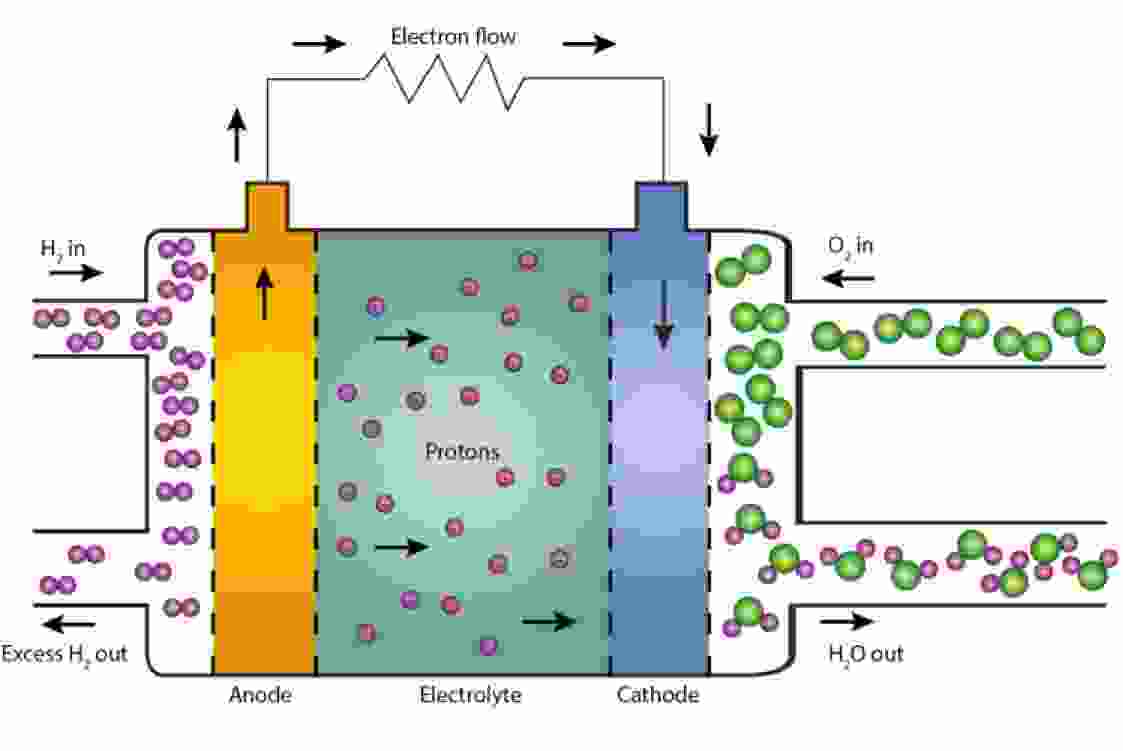
Source: SFA (Oxford)
Platinum and ruthenium are used in fuel cells for the same fundamental reasons as they are in the automotive and chemical industries – they are excellent catalysts that make chemical reactions take place at higher speed, at a lower temperature and at higher rates of conversion than would otherwise be the case, and they are robust under a fuel cell’s harsh operating conditions.
Fuel cell vehicles are really just an alternative type of electrified vehicle powertrain to battery-powered vehicles. Despite these two apparently disparate technologies often being pitted against each other, they share much of the core electrified componentry leading to economies of scale; the size of the battery is the key differentiator, with a much smaller battery in a fuel cell vehicle than in a full battery electric vehicle (BEV).
Outlook for light-duty FCEVs – the visible face of FCs
The rate of adoption of FCEVs into the light vehicle mix over the medium term will vary substantially by region, depending on prosperity, domestic automaker expertise, government policies, driving landscape (distances covered, urban/rural mix), fuelling infrastructure and energy availability. Infrastructure is key – it is vital that the green hydrogen economy develops at a sufficient pace to enable a fuel cell vehicle market to develop.
Japan, the technical pioneer of fuel cells, currently has the highest national FCEV market share. Market pioneers Toyota and Honda, coupled with a national priority to make green and safe energy available within a relatively prosperous, small and self-contained country, have put Japan at the forefront of the FCEV wave. Despite this, the lead times to develop the fuelling infrastructure and vehicle technology should not be underestimated; FCEVs are expected to break through to only 1% of light vehicle production in Japan by 2028.
Passenger car production: 2040
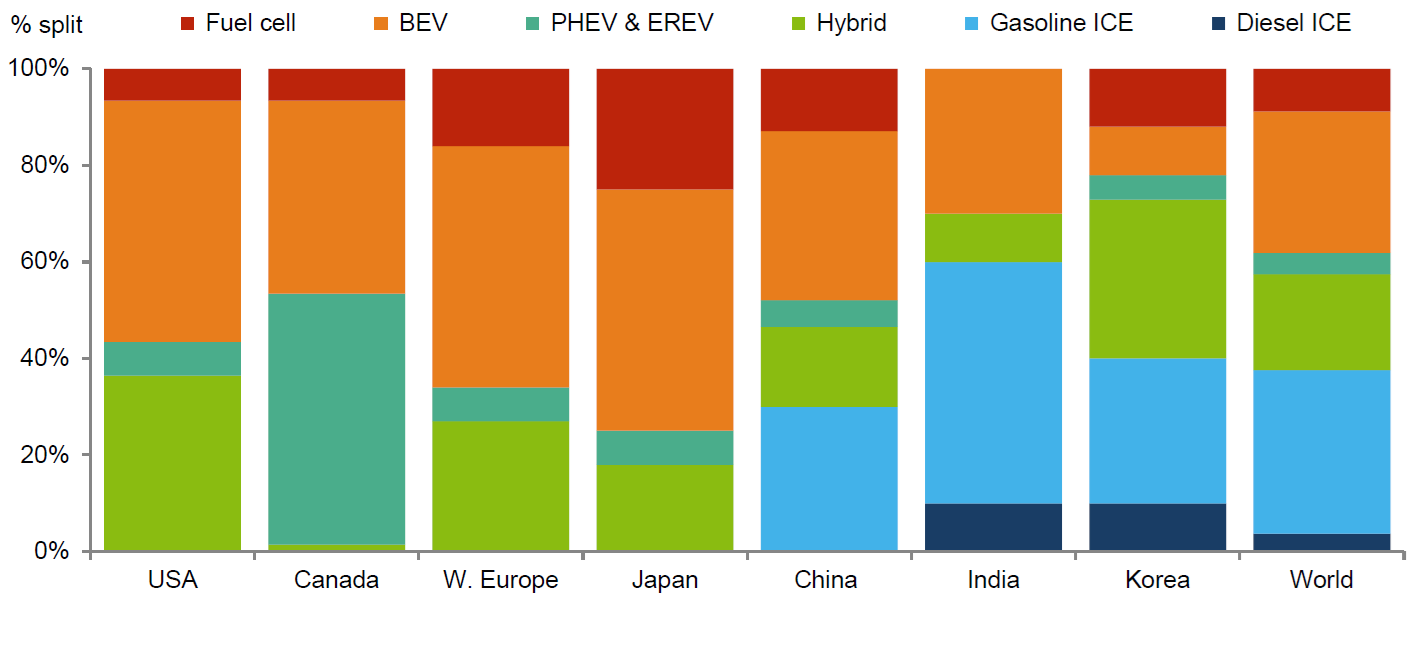
Source: SFA (Oxford), LMC Automotive
Western Europe, with legislated needs to cut all forms of emissions from transport, follows closely, with strengths in the development of fuelling infrastructure and in building collaborations throughout the technology chain. South Korea, with strength in vehicle technologies, is next.
North America and Western Europe are expected to take up FCEVs rapidly in the late 2020s to satisfy the ongoing need for long-distance personal mobility under stringent emissions legislative control. These two regions are estimated to make up three-quarters of production in 2030, but by 2040, China is forecast to account for almost half of the global market.
Global car production
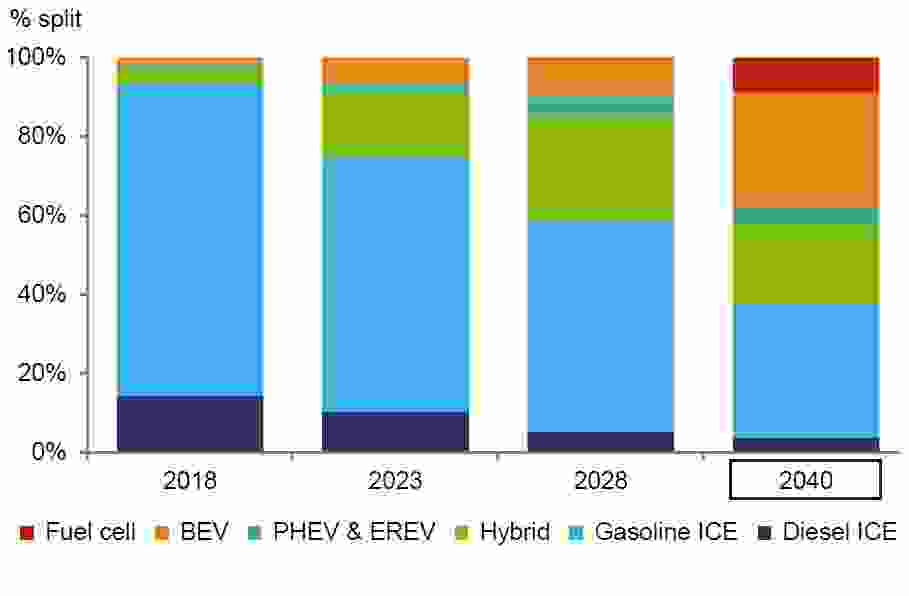
Source: SFA (Oxford), LMC Automotive
China, however, leads the way by absolute FCEV demand thanks to subsidies and air-quality drivers. China is expected to emerge post-2035 and to dominate by 2040. Though a relative laggard in the rate of adoption of fuel cell and hydrogen technology, the sheer size of China’s passenger vehicle market means that by 2040, China will produce almost twice the number of cars as Western Europe, more than three times as many as North America and five times the output of first-mover Japan.
Potential upside for PGM demand
Projections of platinum demand rely on assumptions about platinum loadings per vehicle. Fuel cell cars on the market today from Hyundai, Honda and Toyota have fuel cell stack power outputs ranging from 100 kW to 114 kW. The Toyota Mirai is reported to contain around 30 g of platinum, or 0.26 g per kW. The US Department of Energy (DOE) sponsors research into meeting long-term targets for fuel cell stack performance: its 2020 target for platinum loading is 0.125 g per kW for an 80 kW stack, a loading of 10 g per car.
Our current central case assumes 30 g in 2017, reducing to 12 g by 2021 and to 6 g by 2030, with the latter number broadly equivalent to the platinum loadings on today’s diesel passenger cars. On this basis, demand for platinum would grow to 140,000 oz in 2030 and reach 1.9 moz by 2040.
Passenger cars: FCEV platinum demand, 2018-2040
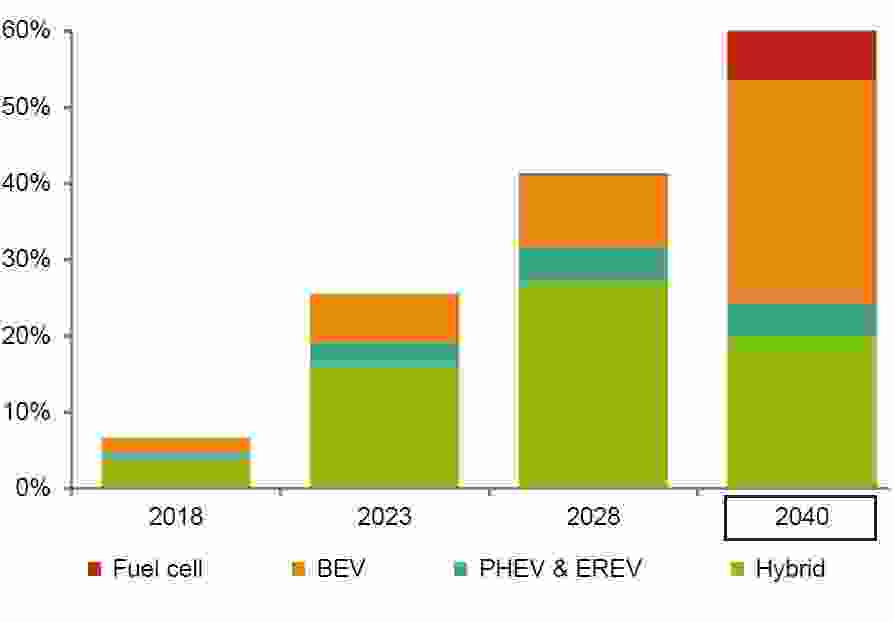
Source: SFA (Oxford). NB: Excludes ICE only.
Platinum demand in fuel cells
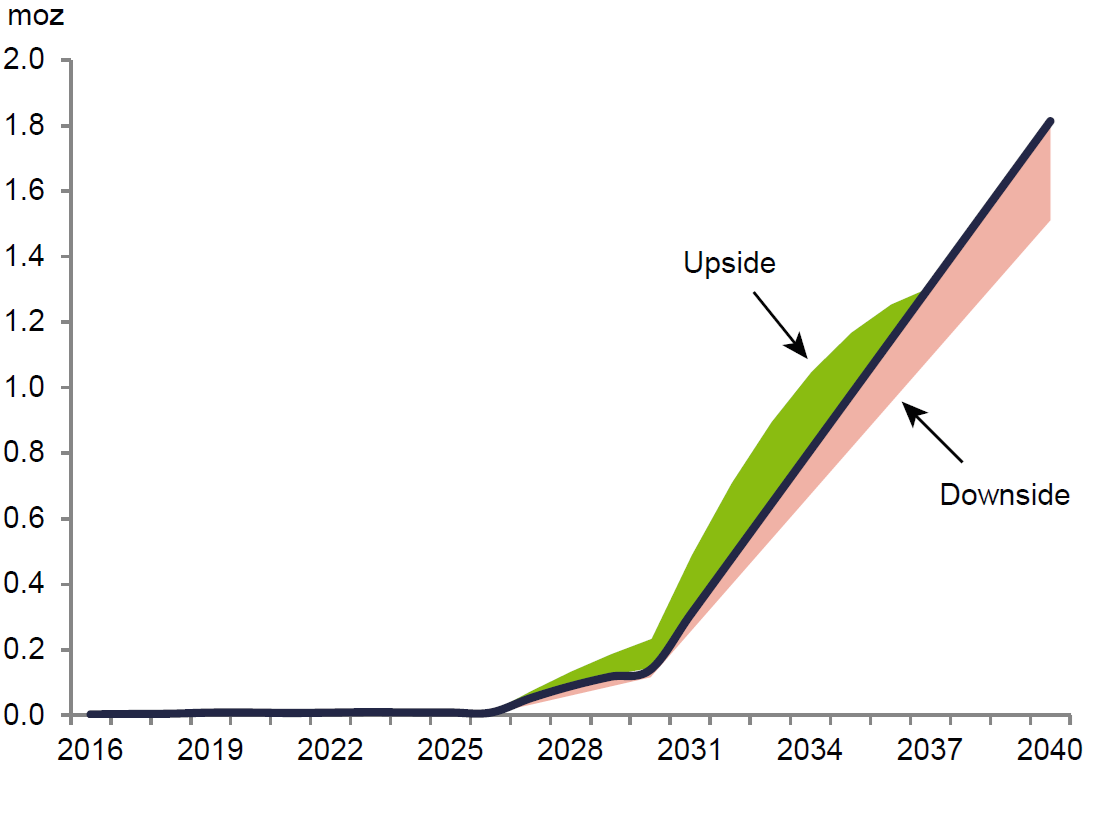
Source: SFA (Oxford)
There would be supplementary demand for ruthenium, which is used to protect platinum catalysts from poisoning by trace carbon monoxide in the hydrogen fuel, and for iridium, used in combination with platinum in electrolysers.
Heavy-duty transport can benefit quickly from FCs
Fuel cells are already taking platinum on a journey into more modes of transport than it has previously experienced as an autocatalyst metal. The PEMFC has been adopted for fuel cell-powered passenger cars and forklift trucks, and is already in commercial use or testing as an alternative electric powertrain for buses, delivery trucks, trains and, excitingly, marine vessels and small aerial vehicles. The need for alternatives to internal combustion engines (diesel, gasoline) is driven by air-quality legislation and the shortcomings of alternatives – for example, electrification of railway lines is very costly; LNG has minimal CO2 improvement in marine applications.
Fuel cells are proving to be a good fit for fleets of vehicles which operate on defined routes out of central depots, as this makes planning the refuelling with hydrogen easier. Fuel cells are a good alternative to diesel power in cities where air pollution is a public health concern: zero emissions at the point of use and a low carbon footprint when hydrogen has been generated from renewable energy are welcomed by city authorities, public transport operators, freight companies and consumers. Consequently, large orders have been placed for heavy-duty fuel cell vehicles by city transport operators (London, Beijing) and haulage contractors (for Budweiser) on the strength of their environmental credentials.
Horses for courses: fuel cells for larger vehicles and longer distances but battery electrics for smaller vehicles and shorter distances
For heavy-duty vehicles, fuel cells make great sense; to increase the range of a vehicle, it is simply a case of adding more hydrogen fuel storage tanks, at a far lower weight penalty than adding more batteries to a fully electric powertrain vehicle. For heavier, longer-range vehicles, the freight industry currently views fuel cell powertrains as lower cost and more suited to applications where a range beyond 350 km is required, while battery-electric powertrains are more suited to shorter journeys.
Hyundai (Korea) and H2 Energy (Switzerland) have identified fuel cell trucks as the route to grow the European hydrogen mobility ecosystem. Hyundai will supply 1,600 fuel cell-powered heavy-duty trucks to the new JV, Hyundai Hydrogen Mobility, between 2019 and 2025, some 600 more than initially announced in 2018. The vehicles will be made available to Swiss customers, initially from the Swiss H2 Association, which includes fuel station operators, retailers and others. Switzerland is a good place to begin, with a stringent road tax on diesel trucks incentivising fleet operators to switch to zero-emission vehicles.
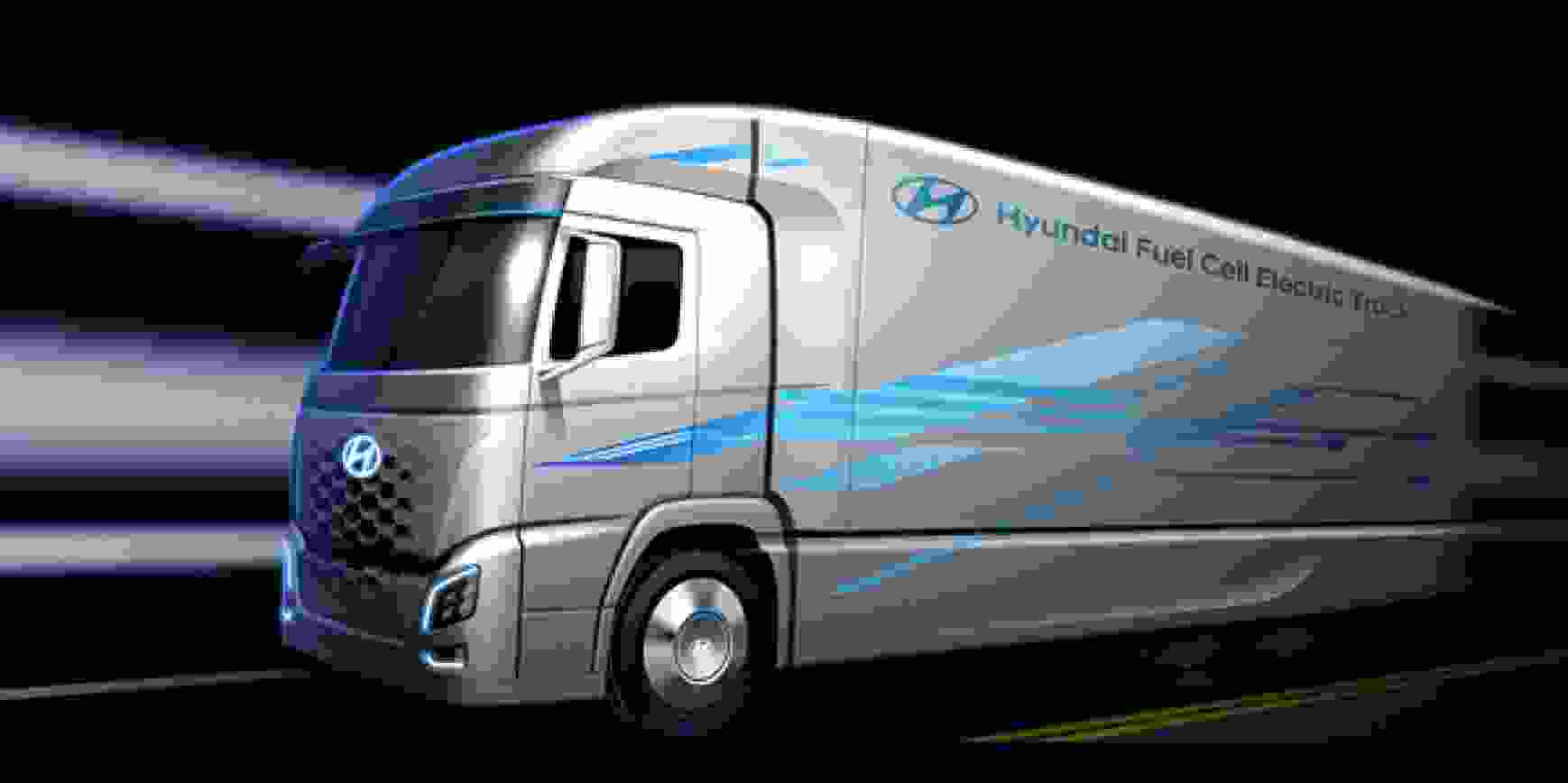
Source: Hyundai
Collaborations are key
Those who have been in the PGM industry for some time will be familiar with the mantra that a sizeable fuel cell market, using PGM catalysts, is always ‘just a few years away’. Why are we saying it’s different this time? We see two key themes that are now in place, but were not there previously. Constructive collaborations and partnerships between companies throughout the supply chain, governments and research institutes bring the commitment, funds, knowledge and vested interest in a successful outcome. Renewable energy, too, has recently improved in efficiency and scale, often supported by state subsidies, to the extent that generated energy is sometimes wasted, but hydrogen is a very convenient storage medium.
Watching the fuel cell industry news announcements, it is very clear now that almost all involve at least two parties; this much deeper level of collaboration than previously seen certainly contributes to upping the pace of progress. At the apex, we have the Hydrogen Council, formed at the beginning of 2017 and grown to over 50 member companies across the value chain, several of whom are very familiar in the PGM industry. The coalition collectively represents total revenues of over €1.8 trillion and close to 3.8 million jobs around the world.
One of the best examples of strategic progress made in collaboration was announced very recently, where a Japanese company is to partner with a Chinese university, which would have been unheard of previously. Toyota, one of the leading Japanese automakers in the global market, recently announced it will set up a research institute with Tsinghua University in Beijing, China. Toyota aims to share more technology in China to grow its business, expanding manufacturing capacity and enhancing distribution channels. Research at the Tsinghua-Toyota Joint Research Institute will aim to solve environmental problems in China, working on consumer cars and on the wider use of hydrogen energy. Toyota is already acting on its plans in the market with strong near-term prospects, announcing in April that it has begun supplying fuel cell vehicle components to Chinese commercial vehicle manufacturers Foton and SinoHytec.
The Chinese government has recently confirmed that it will fully support hydrogen fuel cell technology together with BEVs for the automotive future. The Ministry of Industry and Information Technology said, “Hydrogen fuel-cell vehicles in the future will co-exist and complement electric vehicles to jointly meeting the people's transportation needs. Both lithium battery-powered electric vehicles and hydrogen fuel cell vehicles are important technical solutions for the new energy vehicle segment”. The Chinese authorities recognise that the two technologies serve different markets; battery-powered electric vehicles are well suited to be passenger cars in urban areas, while hydrogen-powered vehicles are better suited as larger commercial vehicles required to cover greater distances.
How companies are managing the steady transition from an oil-based to a hydrogen-based economy
Efficiency gains in renewable energy generation fit very well into the fuel cell industry. Hydrogen, to use as a fuel and as an industrial chemical, can be produced through electrolysis – using electricity to split water into hydrogen and oxygen in an electrolyser, which is effectively a fuel cell operating in reverse. And, like a fuel cell, the electrolyser uses PGMs – in this case, platinum- and iridium-based electrodes to split the water. Coupling locally generated renewable energy (wind, solar) with electrolyser technology allows hydrogen to be used very effectively as a carrier to store excess energy produced from renewables which might otherwise be wasted if the electricity grid cannot take it, and which can later be converted by a fuel cell back into electrical power when required. Producing a practical fuel with minimal carbon content meets environmental legislation and avoids the cost and risks of trucking or piping fuel (such as oil derivatives) from centralised production facilities to customers.
Two of the leading companies in their sectors are collaborating to grow the hydrogen economy in Australia; Toyota has purchased a 0.25 MW rapid response PEM electrolyser from ITM Power. The electrolyser will use renewable energy to split water and generate hydrogen on-site at Toyota’s facilities, for refuelling its fuel cell electric vehicles, including the Toyota Mirai passenger car. Government scientists suggest that Australia could cut global carbon emissions and create a profitable export business producing hydrogen as an energy source to replace fossil fuels for vehicles.
Established companies in the automotive supply chain are also adapting seamlessly to serve the anticipated migration from internal combustion engines to fuel cell powertrains. The Bosch Group has been one of the leading suppliers of innovative components and systems into diesel and gasoline internal combustion engines over many decades. Indeed, the company continues to innovate to support diesel powertrains, with the announcement a year ago of technology which can substantially reduce NOX emissions, keeping diesel powertrains competitive for longer. However, Bosch (Germany) has just announced it will cooperate with PowerCell (Sweden) to co-develop PEM fuel cells that Bosch will then produce globally under licence for trucks and cars, launching in 2022 at the latest.

Disclaimer, copyright & intellectual property
SFA (Oxford) Limited has made all reasonable efforts to ensure that the sources of the information provided in this document are reliable and the data reproduced are accurate at the time of writing. The analysis and opinions set out in the document constitute a judgement as of the date of the document and are subject to change without notice. Therefore, SFA cannot warrant the accuracy and completeness of the data and analysis contained in this document. SFA cannot be held responsible for any inadvertent and occasional error or lack of accuracy or correctness. SFA accepts no liability for any direct, special, indirect or consequential losses or damages, or any other losses or damages of whatsoever kind, resulting from whatever cause through the use of or reliance on any information contained in the report. The material contained herewith has no regard to the specific investment objectives, financial situation or particular need of any specific recipient or organisation. It is not to be construed as a solicitation or an offer to buy or sell any commodities, securities or related financial instruments. The recipient acknowledges that SFA is not authorised by the Financial Conduct Authority to give investment advice. The report is not to be construed as advice to the recipient or any other person as to the merits of entering into any particular investment. In taking any decision as to whether or not to make investments, the recipient and/or any other person must have regard to all sources of information available to him. This report is being supplied to the recipient only, on the basis that the recipient is reasonably believed to be such a person as is described in Article 19 (Investment professionals) or Article 49 (High net worth companies, unincorporated associations etc.) of the Financial Services and Markets Act 2000 (Financial Promotion) Order 2005.
© Copyright reserved. All copyright and other intellectual property rights in any and all reports produced from time to time remain the property of SFA and no person other than SFA shall be entitled to register any intellectual property rights in any report or claim any such right in the reports or the information or data on the basis of which such reports are produced. No part of any report may be reproduced or distributed in any manner without written permission of SFA. SFA specifically prohibits the redistribution of this document, via the internet or otherwise, to non-professional or private investors and accepts no liability whatsoever for the actions of third parties in reliance on this report.
Brought to you by

Dr Jenny Watts
Head of Clean Energy & Sustainability

How can we help you?
SFA (Oxford) provides bespoke, independent intelligence on the strategic metal markets, specifically tailored to your needs. To find out more about what we can offer you, please contact us.
